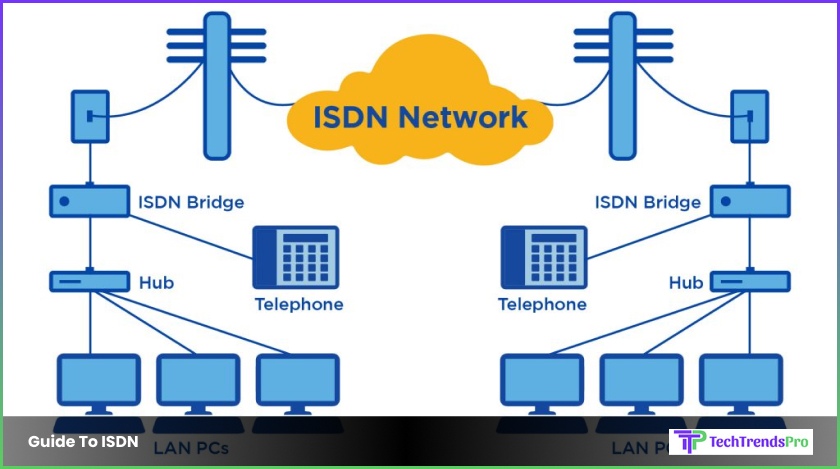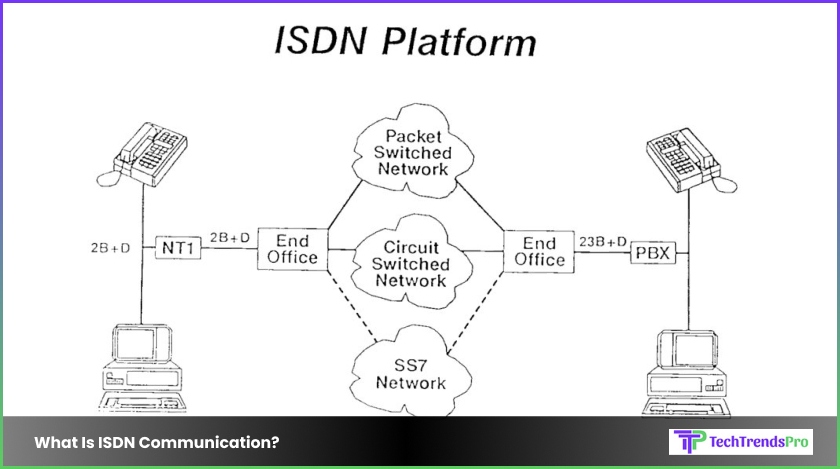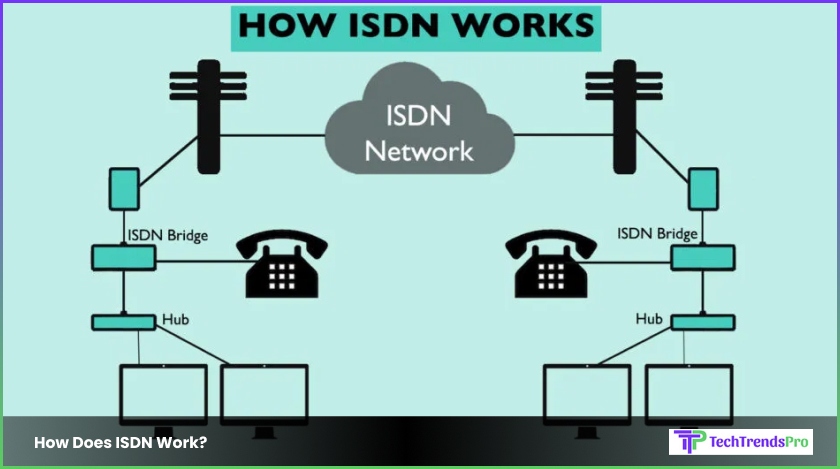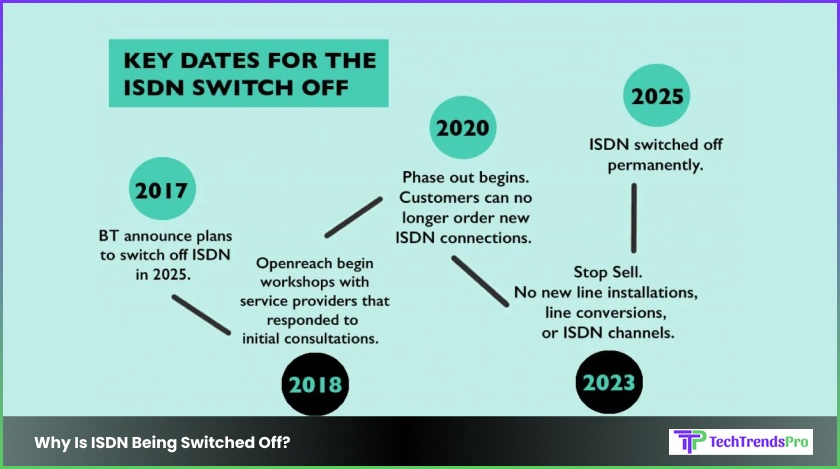
ISDN is a set of communication standards for using digital transmission. Digital transmissions like phone calls and digital data transmissions, and other network services. ISDN is a replacement communication for the public switched telephone network.
ISDN stands for Integrated Services Digital Network. This revolutionary communication system was introduced in 1986 by British Telecom BT. The target of raising this system is easy. The main focus was to replace the old-fashioned landlines and adopt the new digital lines and communications.
Let’s see what the definitions of Integrated Services Digital Network are.
What Is ISDN Communication?

Integrated Services Digital Network is a pack of digital communication. BT introduced this system to minimize the complexity of traditional communications. The Integrated Services Digital Network is replacing the traditional wire communication modules.
ISDN is a pack of transmission norms that use digital communication to make a phone, and video calls, transmit data. Even other network services over the circuits of the traditional PSTN (Public Switched Telephone Network) are provided by the ISDN service providers.
History Of Integrated Services Digital Network
Integrated Services Digital Network was introduced in 1986 by BT. ISDN lines replaced and revised the aging old-fashioned landlines into digital lines. And add more extra features that weren’t available with a traditional telephone system. In 2015 BT was applying restrictions over the purchase of digital lines. And in 2020, they have officially announced their switch-off Plans 2025.
But that does not mean there are no other alternatives available for the ISDN? After the breathtaking announcement of BT. Companies and business organizations are starting to search for an alternative for digital network systems.
Now you know ‘what is ISDN,’ but it is not enough. So here is the ISDN function system.
How Does ISDN Work?

Integrated Services Digital Network has replaced the copper telephone lines. The system allows multiple phones to make and receive calls by using one single physical line.
There are two types of ISDN functions. BRI (Basic Rate Interface) and PRI(Primary Rate Interface).
1. Basic Rate Interface
BRI is made up of 2 bearer channels. These channels are the combination of data, packet networking packets, control, and signaling. BRI is used in many countries, but you can see more profound use of BRI in the residential and small business areas.
2. Primary Rate Interface
PRI is used for carrying the multiple Digital Signal Zero services. ISDN data are working to communicate between the network and the users. But that technique is not suitable for residential areas and small business organizations. For large companies and enterprises, this process is more suitable.
All in all, ISDN operates by converting analog signals into digital format, enabling high-quality transmission. It utilizes two channels: B (Bearer) for data and D (Delta) for signaling. This dual-channel system allows simultaneous voice calls and data transfer. ISDN’s adaptability made it a versatile choice for various applications, from video conferencing to internet connectivity.
Why Is ISDN Being Switched Off?

The infrastructures of Integrated Services Digital Networks have upgraded the traditional communication system and its inception in 1986. The network remained in the unchanged form, and now after the digital communications are stepped in, it is becoming a little outdated.
BT Was mainly invented in the ISDN voice-over. But now, BT analyzed many economic and functional factors. And at last, they understand as they are starting to upgrade their business, they are slowly lacking the residential and houses requirements.
The traditional Integrated Services Digital Network offers flexibility and a fast communication medium. But for this communication, the businesses are bound to a single location. In 2022 no company wants to tie down its business in a single location. Every business wants to expand. And for the expansion, cloud communications are the best techniques.
40% of the business now shifts into IP technology. This is the reason the business handlers are searching for good replacements for Integrated Services Digital Network.
How To Switch Off From ISDN In VoIP?

VoIP uses the internet and cloud system. When you already have the ISDN, shifting to VoIP is the best option. You do not have to install any extra hardware for switching off from the ISDN. This shifting will increase your business flexibility.
Here are step-by-step instructions to shift Integrated Services Digital Networks to VoIP:
Step1: Know your business communication requirements. And fix your phone extension numbers.
Step2: Select a supplier and give him your expected bandwidth measurements. Hence the low bandwidth does provide good connectivity for your phone and computer.
Step3:If your office phone system is not supporting VoIP. You have to replace it with an IP phone system.
These are the three-step easy processes if you like to shift your network communication system from ISDN to VoIP.
How To Switch Off From ISDN In SIP?

The Session Initiation Protocol is a solid protocol used in VoIP communications. The SIP system uses the SIP trunks, allowing flexible communication on a public network system. Now SIP is becoming the most flexible protocol, an excellent alternative for the ISDN.
Here are three easy steps to switching off from ISDN to SIP:
Step1: First, plan the number porting.
Step2: Then select a SIP service provider. Most SIP service providers take care of every hardware and configuration part.
Step3: Sign the agreement and tell the service providers what amount of number you will require to port.
So you can see switching from ISDN to SIP, and VoIP is a pretty convenient process. So you can easily go through these steps and develop a global communication system.
What Are the Advantages Of ISDN?
ISDN offered several advantages in its prime. It ensured clearer voice calls, faster data transfer rates, and reliable connections. Businesses relied on ISDN for its versatility and stability, especially for applications demanding consistent bandwidth, such as telecommuting and video streaming.
- Crystal-Clear Voice Quality: ISDN ensures exceptional voice clarity, making it ideal for important calls and conferences. This superior audio quality minimizes misunderstandings and enhances the overall communication experience.
- High-Speed Data Transfer: ISDN provides lightning-fast data transfer speeds, supporting various applications, from video conferencing to large file uploads. This accelerates data sharing and collaboration among team members.
- Reliable Connection: ISDN offers a dedicated line, guaranteeing a consistent and stable connection. Unlike traditional analog lines, ISDN doesn’t suffer from line noise or interference, ensuring uninterrupted communication.
- Fast Internet Access: ISDN can be used for internet connectivity, offering high-speed access that surpasses many alternatives. It’s especially advantageous for businesses that rely on a dependable online presence.
- Flexibility: ISDN can accommodate multiple channels on a single line, allowing you to adapt your communication setup to your needs. You can allocate channels for voice, data, or video, ensuring efficient resource utilization.
- Scalability: As your business grows, ISDN can easily scale with it. You can add or remove channels as necessary, eliminating the need for significant infrastructure changes.
- Global Reach: ISDN is widely available across the globe, making it an excellent choice for international businesses. It facilitates seamless cross-border communication without compromising quality.
- Enhanced Security: ISDN offers robust encryption options, ensuring the confidentiality of your data and conversations. This is crucial for industries that prioritize data protection.
- Reduced Latency: With low latency levels, ISDN is perfect for real-time applications such as online gaming or video streaming. Users can enjoy smoother, lag-free experiences.
- 24/7 Connectivity: ISDN connections are available around the clock, ensuring that your business can maintain its operations and customer support without interruption.
ISDN And Its Changes!
ISDN evolved over the years, with its variants like BRI (Basic Rate Interface) and PRI (Primary Rate Interface). However, the advent of broadband internet and VoIP (Voice over Internet Protocol) marked the decline of ISDN’s popularity. Its infrastructure became costly to maintain, leading to its gradual phasing out.
In today’s digital era, ISDN has largely become obsolete. Broadband internet and VoIP services have taken over, offering more cost-effective and flexible solutions. While ISDN may still be in use in some legacy systems, its relevance has diminished in favor of modern, IP-based communication technologies.
Frequently Asked Questions (FAQs) About ISDN
Now that you are almost at the end of the age, here are some of the questions that readers frequently ask about ISDN. so check them out before you leave:
1. What Are The Available Switching Technologies For ISDN?
ISDN uses B pipelines for basic traffic communication. In addition, these channels use B channels and D channels to recover the signaling. Each of the B channels supplies a data rate of 64 Kbps.
2. Is ISDN A VoIP?
ISDN is a simple physical connecting process to connect the phone lines. These connections are routed to your calls through your business. VoIP is simply cut through the excess leased lines. This simple protocol is very effective in eliminating your call costs.
3. How Much Does An ISDN System Cost?
64K ISDN Line costs are around $140 install, along with $38/mobile usages.
Internet access with installations costs $15 for a single time.
4. Are There Any Advantages Of ISDN Service?
Yes, there were multiple advantages of using the ISDN services. When a user has multiple digital channels, ISDN has maximum benefit for it. ISDN allows multiple channels operations through a single channel.
Conclusion
For staying in today’s competitive market, all businesses require a broad global platform. When you are having the ISDN, I think you are already voting for shifting to more intelligent technologies. There is no doubt that the cloud system is more versatile and gives you a large area for communications. There is no exact boundary for cloud systems. If you like to switch off from ISDN, you will get many service providers. But for porting or switching, evaluate the requirements of the changes. Then start the change process.
Read Also:






